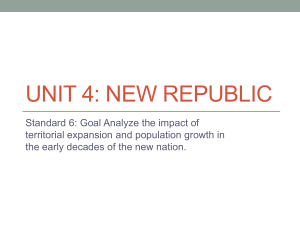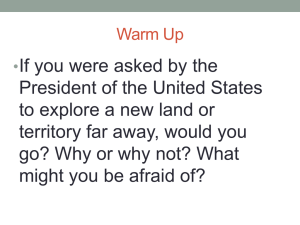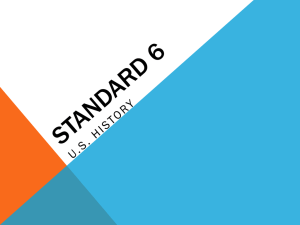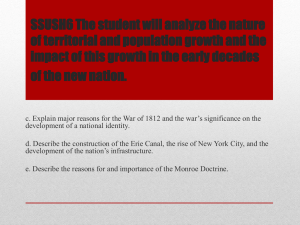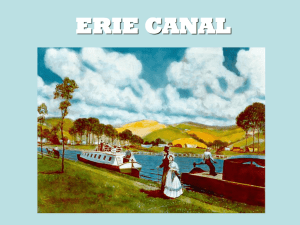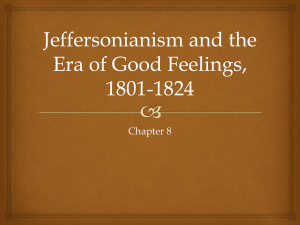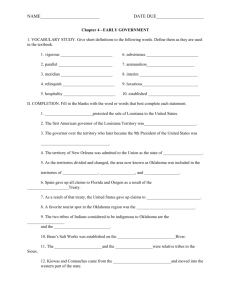File
advertisement
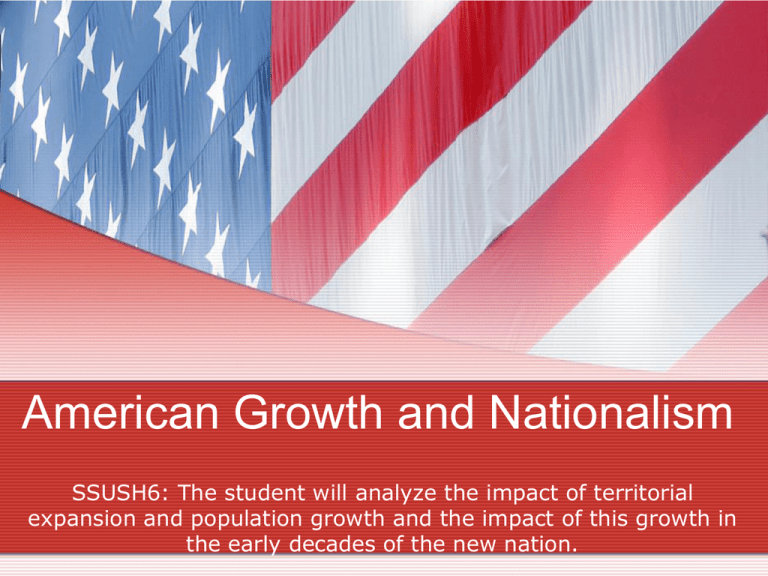
American Growth and Nationalism SSUSH6: The student will analyze the impact of territorial expansion and population growth and the impact of this growth in the early decades of the new nation. Westward Expansion • Northwest Ordinance- created the western territory (North of Ohio R., East of Miss. R.) • 5,000 people- could elect legislature • 60,000 people- could apply for statehood • Slavery was not allowed – this would lead to just slavery in the South • Created 5 states: Ohio, Indiana, Illinois, Michigan and Wisconsin. • Many Americans moved to the area between the App. Mts. and the Mississippi R. because of abundant land and fertile soil • The increase of white settlers led to tension with Native Americans. Main Ideas of Thomas Jefferson’s Presidency 1. Informal style for the presidency 2. More power for Supreme Court 3. Expand west so more people could own land 4. Keep U.S. out of war between Britain and France Informal style of Jefferson’s presidency • He felt like Washington & Adams acted too much like royalty 1.Instead of overturning all of the Federalists policies, Jefferson sought to integrate them with his own Democratic-Republican ideas 2.A strong believer in small government, Jefferson hoped to limit federal power Jefferson gave more power to the Supreme Court 3. Marbury v. Madison decision strengthened the Supreme Court because it a gave the Supreme Court the right of judicial review Louisiana Purchase 4. In 1803 Napoleon offered to sell all of the Louisiana Territory, as well as New Orleans, to the United States 5. “Corps of Discovery” (Lewis and Clark Expedition) not only increased American knowledge of the Louisiana Territory, it also gave the United States claim to the Oregon territory along the west coast Lewis and Clark Expedition • Meriwether Lewis and William Clark • Secret expedition to find a route to the Pacific Ocean • Sacagawea – Shoshone Native American women – served as guide and interpreter • Greatly increased knowledge on the plants, animals, and geography of the new territory The Decision for the War of 1812 Impressment British ships were stopping American ships and forcing our sailors into their navy (AKA shanghai) War Hawks South and West- supported war (War Hawks) because trade restrictions had hurt farmers and blamed British for the clashes with Native Americans. Trade Problems Both France and Great Britain had been disrupting trade between themselves, America would get caught in the middle. Great Britain’s trade restrictions on the U.S. would eventually lead to war War declaration June 1812- Madison asked Congress to declare war. South & West voted for war. Northeast against war. Important Battles and the War Ends Raids on D.C. & Baltimore British seized the capital and burned it and the White House. Next attack on Baltimore unsuccessful (Ft. McHenry- Francis Scott Key’s Star Spangled Banner). Battle of New Gen. Andrew Jackson used cotton bales to absorb Orleans bullets. The American victory made Jackson a hero & destroyed the Federalists. Nationalism was strong. Battle took place 2 weeks after the war ended Treaty of Ghent December 24, 1814- Treaty of Ghent ended war & restored prewar boundaries. No territory changed hands. Result of war The war increased American prestige overseas and created a new feeling of patriotism and national unity. Judicial Nationalism 1816-1824: Chief Justice John Marshall ruled in cases that established power of the federal government over the states. Marbury v. Madison Declared congressional act unconstitutional; created power of judicial review Nationalistic actions against Spain Invasion of Florida 1. Spanish-held Florida angered Southerners becausea. b. 2. 3. Runaway slaves fled there Seminoles used Florida as a base to raid Georgia. 1818- General Andrew Jackson seized Spanish settlements & removed the governor Adams-Onís Treaty of 1819 - Spain ceded Florida to the U.S. The treaty also created the border between U.S. and Spain territory out west Changes In Transportation and the Nations Infrastructure Steam Power *1807- Robert Fulton’s Clermont steams up the Hudson River •Steamships helps farmers ships their goods Canals *Erie Canal connects Lake Erie to New York City *By 1840 3,000 miles of canals are in use Changes In Transportation Roads *By 1833, the Cumberland Rd runs from Maryland to Ohio *New roads of stone & gravel help Americans move West Railroads *In 1828 the B & O line becomes the Nation’s first railroad *By 1840 US has more RR than any other place in the world Robert Fulton’s Clermont The Erie Canal The Erie Canal • 1825- was the example of changes in transportation • Society and economic changes took place • Connected Lake Erie to New York’s Hudson River • The Erie Canal was the first transportation faster any other form at the time. Connected the eastern seaboard to the new western territory which was then wilderness. • New York had a massive population surge, and became an economic center President James Monroe The Era of Good Feelings • After the War of 1812, Americans had a sense of national pride. Americans felt more loyalty toward the United States than toward their state or region. The presidency of James Monroe is described as the Era of Good Feelings. The Monroe Doctrine • Many Spanish colonies were revolting against Spanish Colonialism • The US was for the revolts – why? • TRADE was more favorable to the US with the independent countries • Other European countries might try to colonize the Western Hemisphere (The Americas) • President would create the Monroe Doctrine (policy) to stop future European influence in the Americas- even though we had no power to implement the policy or back it up The Monroe Doctrine 1. U.S. would stay out of European affairs and Europe should stay out of Western Hemisphere 2. No more colonization of the West – if you are already here it is OK but you can not create anymore colonizes 3. An attack against a country in the West is an attack against the U.S. 4. The U.S. would remain neutral concerning European Affairs
